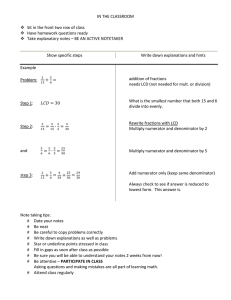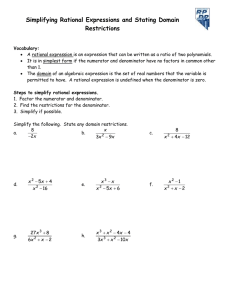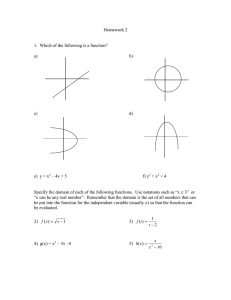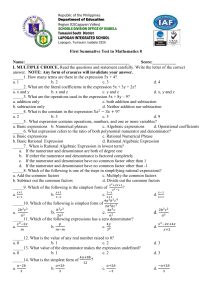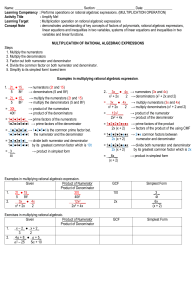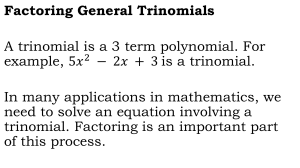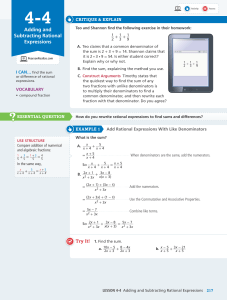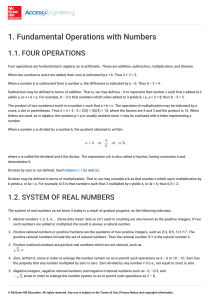Section 1.4 Rational Expressions
advertisement
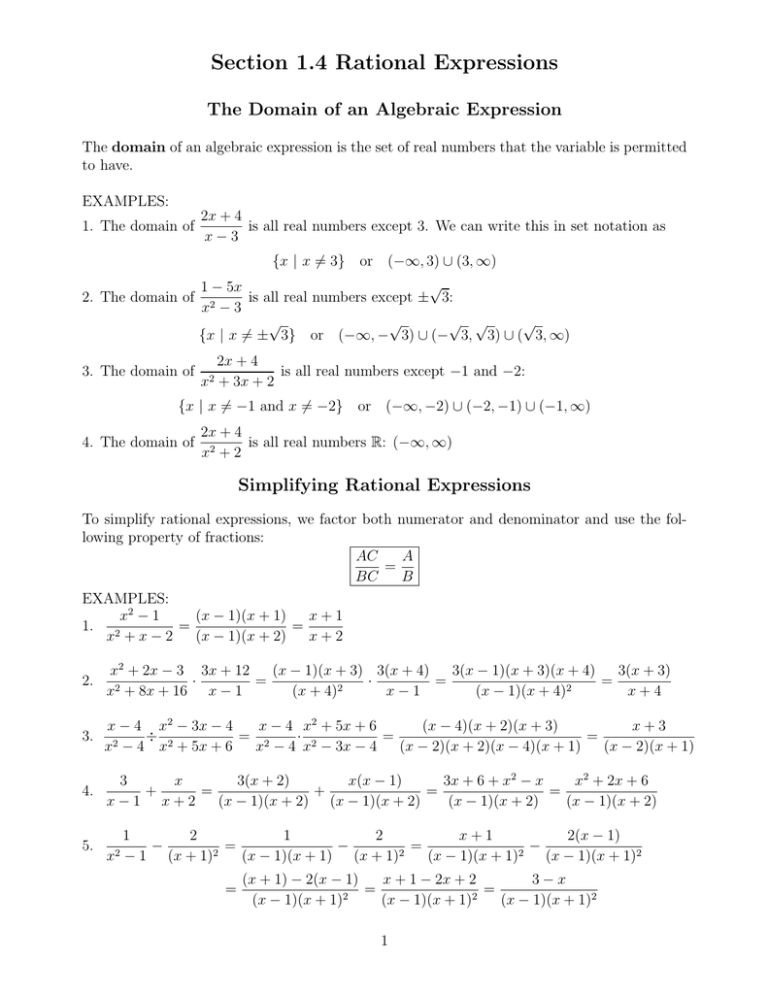
Section 1.4 Rational Expressions
The Domain of an Algebraic Expression
The domain of an algebraic expression is the set of real numbers that the variable is permitted
to have.
EXAMPLES:
1. The domain of
2x + 4
is all real numbers except 3. We can write this in set notation as
x−3
{x | x 6= 3} or (−∞, 3) ∪ (3, ∞)
2. The domain of
3. The domain of
√
1 − 5x
3:
is
all
real
numbers
except
±
x2 − 3
√
√
√ √
√
{x | x 6= ± 3} or (−∞, − 3) ∪ (− 3, 3) ∪ ( 3, ∞)
2x + 4
is all real numbers except −1 and −2:
x2 + 3x + 2
{x | x 6= −1 and x 6= −2} or (−∞, −2) ∪ (−2, −1) ∪ (−1, ∞)
4. The domain of
2x + 4
is all real numbers R: (−∞, ∞)
x2 + 2
Simplifying Rational Expressions
To simplify rational expressions, we factor both numerator and denominator and use the following property of fractions:
AC
A
=
BC
B
EXAMPLES:
(x − 1)(x + 1)
x+1
x2 − 1
=
=
1. 2
x +x−2
(x − 1)(x + 2)
x+2
2.
x2 + 2x − 3 3x + 12
(x − 1)(x + 3) 3(x + 4)
3(x − 1)(x + 3)(x + 4)
3(x + 3)
·
=
·
=
=
2
2
2
x + 8x + 16 x − 1
(x + 4)
x−1
(x − 1)(x + 4)
x+4
3.
x − 4 x2 − 3x − 4
x − 4 x2 + 5x + 6
(x − 4)(x + 2)(x + 3)
x+3
÷
=
· 2
=
=
2
2
2
x − 4 x + 5x + 6
x − 4 x − 3x − 4
(x − 2)(x + 2)(x − 4)(x + 1)
(x − 2)(x + 1)
4.
3
x
3(x + 2)
x(x − 1)
3x + 6 + x2 − x
x2 + 2x + 6
+
=
+
=
=
x−1 x+2
(x − 1)(x + 2) (x − 1)(x + 2)
(x − 1)(x + 2)
(x − 1)(x + 2)
5.
x2
2
2
1
x+1
2(x − 1)
1
−
−
=
=
−
2
2
2
− 1 (x + 1)
(x − 1)(x + 1) (x + 1)
(x − 1)(x + 1)
(x − 1)(x + 1)2
=
x + 1 − 2x + 2
3−x
(x + 1) − 2(x − 1)
=
=
2
2
(x − 1)(x + 1)
(x − 1)(x + 1)
(x − 1)(x + 1)2
1
Compound Fractions
A compound fraction is a fraction in which the numerator, the denominator, or both are
themselves fractional expressions.
EXAMPLES:
x y
x+y
x
+1
+
x+y
x
x(x + y)
y
y y
y
11 .
y = x y = x − y = y · x − y = y(x − y)
−
1−
x
x x
x
x
x
x
+ 1 xy
+1
· xy + 1 · xy
x(x + y)
x2 + xy
y
y
y
12 .
=
=
=
=
y
y
y
2
xy − y
y(x − y)
1−
1 · xy − · xy
1−
xy
x
x
x
a − (a + h)
1
1
−
a − (a + h) 1
a−a−h 1
−h
1
−1
a(a + h)
2. a + h a =
=
· =
· =
· =
h
h
a(a + h)
h
a(a + h) h
a(a + h) h
a(a + h)
31 .
(1 + x2 )−1/2 [(1 + x2 ) − x2 ]
(1 + x2 )−1/2
1
(1 + x2 )1/2 − x2 (1 + x2 )−1/2
=
=
=
2
2
2
1+x
1+x
1+x
(1 + x2 )3/2
32 .
(1 + x2 )1/2 − x2 (1 + x2 )−1/2 (1 + x2 )1/2
(1 + x2 ) − x2
(1 + x2 )1/2 − x2 (1 + x2 )−1/2
=
·
=
1 + x2
1 + x2
(1 + x2 )1/2
(1 + x2 )3/2
=
1
(1 + x2 )3/2
Rationalizing the Denominator or the Numerator
EXAMPLES:
√
√
√
√
1 · (1 − 2)
1− 2
1− 2
1− 2 √
1
√ =
√
√ =
√
=
=
= 2−1
1.
1−2
−1
1+ 2
(1 + 2) · (1 − 2)
12 − ( 2)2
2.
√
√
√
√
( 4 + h)2 − 22
4+h−2
( 4 + h − 2)( 4 + h + 2)
4+h−4
h
√
= √
=
= √
= √
h
h( 4 + h + 2)
h( 4 + h + 2)
h( 4 + h + 2)
h( 4 + h + 2)
=√
3. Evaluate
√
1
1
1
√ +√
√ +√
√
1+ 2
2+ 3
3+ 4
2
1
4+h+2
3. Evaluate
√
1
1
1
√ +√
√ +√
√
1+ 2
2+ 3
3+ 4
Solution: We have
1
1
1
1
1
1
√ +√
√ +√
√ =√
√ +√
√ +√
√
√
1+ 2
2+ 3
3+ 4
2+ 1
3+ 2
4+ 3
√
√
√
√
√
√
2− 1
3− 2
4− 3
√ √
√ √
√ + √
√ √
√ + √
√
= √
( 2 + 1)( 2 − 1) ( 3 + 2)( 3 − 2) ( 4 + 3)( 4 − 3)
√
√
√
√
√
√
2− 1
3− 2
4− 3
√
√
√
= √
+ √
+ √
( 2)2 − ( 1)2 ( 3)2 − ( 2)2 ( 4)2 − ( 3)2
√
√
√
√
√
√
√
√
√
√
√
√
2− 1
3− 2
4− 3
2− 1
3− 2
4− 3
+
+
=
+
+
=
2−1
3−2
4−3
1
1
1
√
√
√
√
√
√
√
√
= 2− 1+ 3− 2+ 4− 3=− 1+ 4=1
REMARK: In the same way one can prove that
√
1
1
1
√ +√
√ + ... + √
√
√ = n−1
n−1+ n
1+ 2
2+ 3
Rationalizing the Denominator or the Numerator
Don’t make the mistake of applying properties of multiplication to the operation of addition.
Many of the common errors in algebra involve doing just that. The following table states several
properties of multiplication and illustrates the error in applying them to addition.
3


